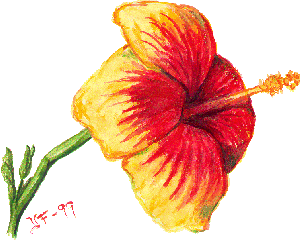|
|
|
 |

|
Ever wondered how plants know when to grow and when to bloom, why roots grow at the bottom and shoots at the top? It all comes down to hormones. Really, water and nutrition would be useless if it was not for these willing workers. So why should you know or care about the inner workings of your plants? A rudimentary understanding of plant development will aid you to become a better gardener. Other sections of this site explain how you prune, repot, propagate etc. while this page explains why. Most texts on the subject are complicated and the main points easily escape the layman, which is why this page was written to explain the basics in a straight forward manner. There are several hormone groups that control plant development, the most prominent being auxins and cytokinins. Auxins are mainly responsible for plant growth, while cytokinins are heavily into building roots. This works like a see-saw: If the auxin level is too high, a plant will grow up top but not set new roots; if the level of cytokinins is too high the plant may be busy developing roots but not grow much. So to improve your rooting rate you may add rooting hormones (cytokinins) and to make it grow faster you add growth hormones (auxins). Auxins are responsible for cell elongation, that is, stretching the existing cells so they become bigger and can transport more nutrients. Cytokinins are responsible for cell division, which create roots and is responsible for branching. Hence, cytokinin is found primarily in roots and new shoot tips, while auxins in leaves and branches as well as in buds, blooms and seedpods. Notice how most hibiscus stops growing when it sets buds? That's because the auxins are now taking over the tips and suppresses the cytokinins. Here's a very interesting thing: By pruning you reverse the hormone flow in your plant. How? The cytokinins travel between roots and shoot tips to develop the plant and make it bigger, which means both more branches and more roots. This exchange is now interrupted; there are no shoot tips. So the cytokinins go back down and grow some more roots. Then, when the cells have healed they again concentrate at the tip, breaking the temporary dormancy at the topmost leaf node, induce cell division to make a new shoot. The very tip of the new shot is called the meristem and it is jam packed with hormones. Now apply this information to rooting cuttings. We usually trim cuttings in the belief that a smaller leaf surface will aid the cutting in preserving water during its rootless state and this is true. However, the greater benefit is that by removing the tip growth of that cutting we reverse the direction of the cytokinins so they concentrate at the bottom of the cutting where we want them to be. The first sign of rooting is often the callus, a whitish substance, but this is not yet roots. This is the plant's version of stem cells, cells that have not made up their mind yet what they are to become, roots or shoots. Callus is a good sign because it indicates cell division - our cytokinins are hard at work. However, if the auxin level in a plant is too high then the cytokinins are pushed toward the tips regardless. This will initially cause a lot of branching and new growth on a rootless cutting. Unfortunately, as Tom stated, since there are no roots to import more nutrients the plant's food supply is limited, hence the unrooted cutting eventually exhausts its reserves and dies. Changing the balance by increasing the amount of cytokinins, adding rooting hormones in other words, may work, but if the plant has too much auxin it might not be enough - we have learnt to add hormones but not to extract them. In the horticultural trade manmade growth regulating hormones are used in conjunction with synthesized versions of the root and growth hormones. Cycocel is perhaps the most widely used as it (or its successors) is applied to most potted plant, as well as nearly all annual bedding out plants. Hibiscus is particularly sensitive to these growth inhibitors. The above is under ideal conditions. Unfortunately there are enemies to rooting, such as fungus and bacteria, that messes up the rooting by attacking the bottom of the cutting, the callus, or simply by creating a toxic environment where any roots developed cannot grow. But that's another story. ------------------ |